NUTRITION IN ANIMALS for Class 7 SCIENCE
INTRODUCTION
Hamne chapter 1 mein padha ki plants apna khana khud photosynthesis ki process se banate hai. Ab iss chapter mein hum padhenge ki animals apna nutrition (khana) kaha se lete hai, kaise lete hai (mode of nutrition), aur usko body mein kaise utilise karte hai. Animals apna khana directly plants se lete hai ya fir un animals se lete hai jo plants ko khate hai. Kuchh animals aise bhi hote hai jo plants aur animals dono ko hi khate hai. Jaisa ki hamne last chapter mein padha tha ki plants ka mode of nutrition autotrophic hota hai. Ab hum animals ke mode of nutrition ke baare mein padhenge, unki different food habits ke baare mein padhenge. Hum yeh bhi jaanege ki humans mein food kaise digest hota hai, grass eating animals mein kaise digest hota hai etc.
LET'S UNDERSTAND SOME FOOD HABITS OF DIFFERENT ANIMALS
Jaise ki last chapter mein hamne padha ki plants apna khana photosynthesis ke process se khud banate hai. Ab hum animals ki eating habits ke baare mein study karte hai aur different food habits ke according inko different categories mein divide karte hai. Eg- Herbivore, carnivore, omnivore, parasites and scavengers etc. Niche figure mein hum dekhte hai ki kounse animals ki kya food habits hai.
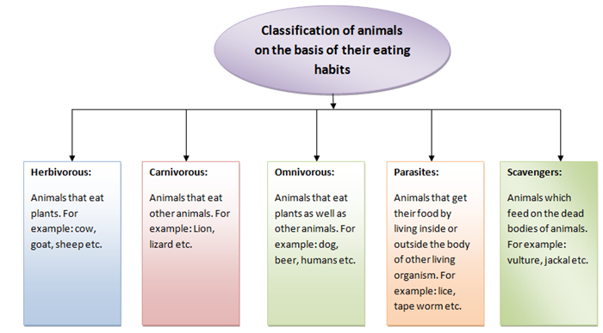
Mode Of Nutrition In Animals- Heterotrophic Mode Of Nutrition
Animals follow heterotrophic mode of nutrition kyunki wo apna khana dusro se obtain karte hai. Heterotrophic mode of nutrition further holozoic, saprophytic aur parasitic nutrition mein divided hai.

Ab holozoic mode of nutrition further herbivores, carnivores aur omnivores mein classified hai-

Sabhi organisms ko survive karne ke liye; apni body ki growth, repairing aur functioning ke liye nutrition ki jarurat hoti hai. Hamne yeh bhi last chapter mein padha tha ki hamare food mein bahut saare components present hote hai jinko hum nutrients kehte hai. Lekin kya yeh nutrients hamari body directly use kar pati hai?
No, hamari body in sabhi nutrients ko pehle simple substances mein convert karti hai aur fir utilise karti hai. Ab yeh saari process kaise hoti hai? Yeh hum detail mein aage padhenge.
“ Complex food substances ko simple substances mein convert karne ke process ko digestion kehte hai.”
POINT 1
Nutrition: The process of utilization of food by a living organism to obtain energy is called nutrition.
Herbivore: The organisms that feed on plants are called herbivores..
Carnivores: The organisms that take their nutrition from other animals are called carnivores..
Omnivores: The organisms which take their nutrition from both plants and animals are called omnivores.
DIFFERENT WAYS OF TAKING FOOD
Different organisms different ways se apna food lete hai. Eg- Humans, Snail, Aunt etc. apna food Chew karte hai; Cow, Buffalo etc. apna food swallow karte hai; Hummingbird, Lice etc. apna food Sucking karke lete hai. Niche di hui table mein kuchh organisms ke name, unka food aur food ko khane ka way bataya gaya hai.

DIGESTION IN HUMANS
Jaisa ki hamne abhi padha ki kuchh organisms complex food material khate hai aur usko simple substance mein convert karke body mein utilise karte hai. Human beings bhi aise hi animals hai jo apna khana mouth ke through ingest (khate) karte hai, body ke andar usko digest karte hai, usko apni body mein utilise karte hai aur baki bacha hua material body se bahar nikal dete hai.
Ab hum humans ki puri digestion process ko detail mein padhenge aur jaanege ki hum jo food khate hai wo kaha jata hai aur kaise jata hai?

The Human Digestive System
Human digestive system mein alimentary canal (digestive tract) aur secretory glands hote hai. It includes-Ab hum in sabhi parts ke functions ka ek overview dekhenge aur fir inko detail mein padhenge.

Alimentary Canal mouth se start hoti hai aur anus tak jaati hai. Digestion bhi mouth se hi start ho jaati hai aur anus par end hoti hai. Food jaise hi mouth mein enter karta hai wahi se digestion process start ho jata hai. Aur jaise food body mein aage travel karta rehta hai digestion ka process chalta rehta hai. Hamari body ke andar kuchh glands bhi present hote hai jo digestive juices secrete karte hai aur food ko digest karne mein help karte hai. Eg- Salivary glands, Liver and Pancreas.
Digestive tract aur digestive glands dono ek saath milkar digestive system banate hai. Ab hum padhenge ki jab food body ke different parts mein travel karta hai toh kya hota hai. Sabse pehle hum food ko khane ke liye apne mouth (buccal cavity) mein daalte hai aur fir aage ka process start ho jata hai.
Pehle hum in steps ke baare mein thoda jaan lete hai fir isko detail mein padhenge See figure.
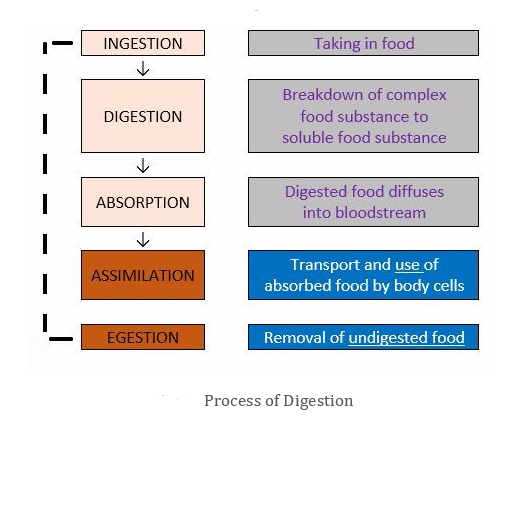
The Mouth And Buccal Cavity
Buccal cavity ko hum commonly mouth bhi kehte hai. Buccal cavity mein teeth aur tongue present hote hai. Yha salivary glands bhi present hote hai. Humans apna food mouth se body mein ingest (enter) karte hai aur is process ko ingestion kehte hai.
“ Food ko body mein ingest karne ki process ko ingestion kehte hai. Yeh animals mein nutrition ka first step hai.”
Teeth: Hamare mouth mein different type ke teeth present hote hai aur in sabhi ka different function hota hai.

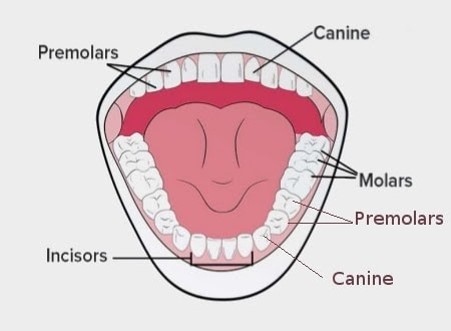
Incisors: Hamare mouth mein sabse aage jo teeth hote hai unko incisors kehte hai. Incisors 4 hote hai. Yeh food ko cut aur bite karte hai.
Canines: Incisors ke piche 2 pointed teeth hote hai, yeh canines hote hai. Canines 2 hote hai. Yeh food ko tear karke chote pieces mein convert karte hai.
Premolars: Premolars canine ke piche present hote hai. Premolars ek jaw mein 4 hote hai. Yeh food ko chew aur grind karte hai.
Molars: Premolars ke piche molars hote hai. Molars ek jaw mein 6 hote hai. Yeh food ko chew aur grind karne mein help karte hai.
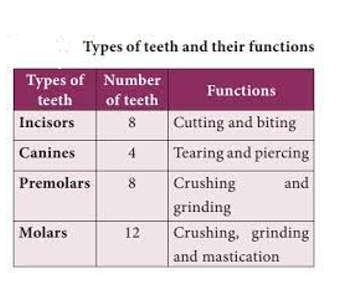
Humans ke pure life span mein two sets of teeths hote hai- Milk teeth and Permanent teeth.
Yeh teeth lifetime rehte hai ya fir old age mein toot jaate hai. Koi dental disease hone ki wajah se bhi ye toot jaate hai. Dental disease kaise hoti hai iske liye hum aage tooth decay ke baare mein padhenge.
Tooth Decay

So teeth ko theek rakhne ke liye hamein kya karna chahiye??
Tooth Decay Prevention
Tongue

Salivary Glands
Food Pipe/ Oesophagus

POINT 2
Alimentary canal/ Digestive tract: A long tube running from mouth to anus of a human being in which digestion and absorption of food takes place is called alimentary canal..
Ingestion: The process of consumption of food into the body is called ingestion..
Digestion: The process by which complex food material is broken down into simple absorbable substances is called digestion..
Salivary glands: A group of organs present in our mouth that secretes saliva are called salivary glands..
Tongue: It is a muscular organ connected to the back of the buccal cavity..
Incisors: These are the chisel shaped teeth at the front of the mouth..
Canines: These are the large, pointed teeth just behind the incisors..
Premolars: These are the large teeth just behind canines on each side..
Molars: Molars are very large teeth which are present just behind premolars, towards the back of our mouth..
Tooth decay: Tooth decay is damage to a tooth’s surface, or enamel. It happens when bacteria in your mouth makes acids that attack enamel.
Stomach
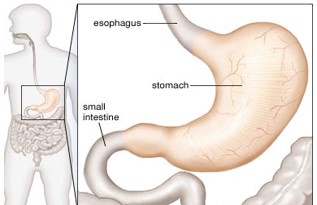
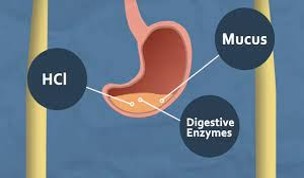
Small Intestine
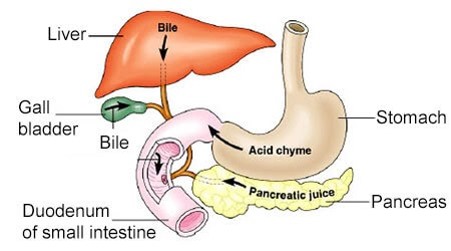
Liver
Pancreas
Pancreas ek cream color ka gland hota hai. Yeh just stomach ke niche present hota hai. Ye pancreatic juice secrete karta hai aur pancreatic juice carbohydrate, fats aur proteins par act karke usko completely digest karta hai. Ab partially digested food small intestine ke lower part mein jata hai jaha par intestinal juices saare components ka digestion complete karte hai aur complex substances ko simple mein convert karte hai. Carbohydrate ko glucose, fats ko fatty acid and glycerol aur proteins ko amino acids mein convert karta hai.Absorption in small intestine
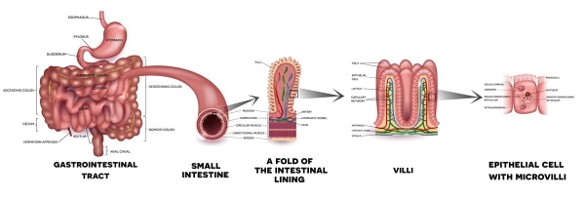
POINT 3
Absorption: The process of passing digested food into blood vessels in the intestine is called absorption..
Assimilation: The conversion of absorbed food in complex substances such as proteins and vitamins required by the body is called assimilation..
Villi: The finger-like outgrowths on the inner walls of the small intestine are called villi.
Large Intestine
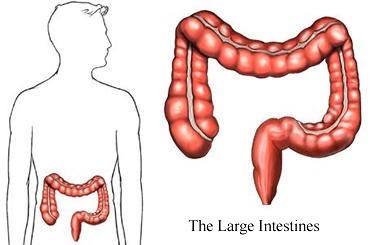
Ab hum niche diye gaye flowchart ka ek overview lekar bhi samajh sakte hai ki food kaise body mein travel karta hai.

DIGESTION IN GRASS EATING ANIMALS

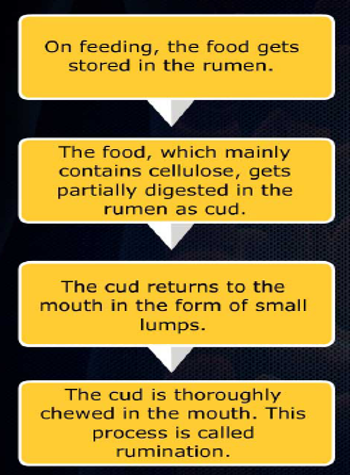
Abhi tak hamne aise organisms ke baare mein padha jinki body mein digestive system hota hai. Lekin kuchh aise organisms hote hai jinme na to khana khane ke liye mouth present hota hai aur na hi excrete karne ke liye anus hoti hai. Ab hum kuchh aise hi organisms ke baare mein padhenge.
POINT 4
Rumen : It is the largest first compartment of the stomach of a ruminant in which cellulose is broken down by the action of bacteria..
Cud: The partially digested food in the reticulum is called cud..
Ruminants: Grass eating animals like cows, buffaloes etc. are called ruminants..
Rumination: Rumination is the process by which cud returns to the mouth in small lumps and then the animal chews it.
FEEDING AND DIGESTION IN AMOEBA
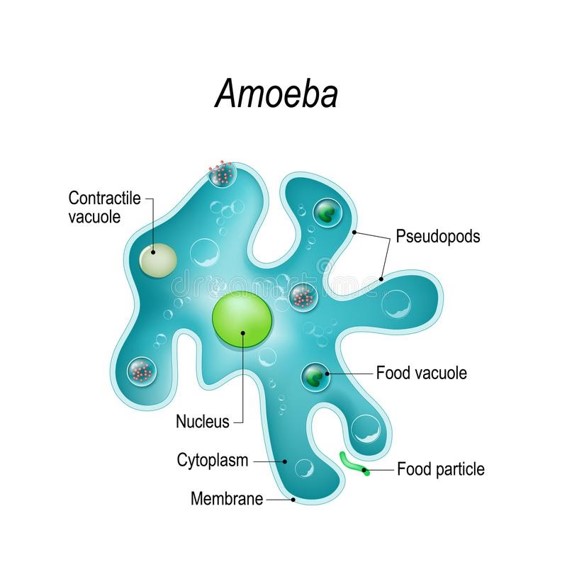
Steps of nutrition in amoeba
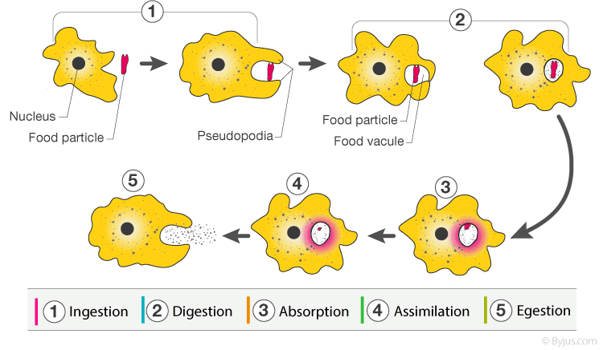
POINT 5
Pseudopodia: The false feet formed by amoeba around food particles to engulf it, is called pseudopodia.
Summary
1. Animal nutrition includes nutrient requirement, mode of intake of food and its utilisation in the body.
2. The human digestive system consists of the alimentary canal and secretory glands. It consists of the (i) buccal cavity, (ii) oesophagus, (iii) stomach, (iv) small intestine, (v) large intestine ending in rectum and (vi) anus. The main digestive glands which secrete digestive juices are (i) the salivary glands, (ii) the liver and (iii) the pancreas. The stomach wall and the wall of the small intestine also secrete digestive juices.
3. The modes of feeding vary in different organisms.
Nutrition is a complex process involving: (i) ingestion, (ii) digestion, (iii) absorption, (iv) assimilation and (v) egestion.
4. Digestion of carbohydrates, like starch, begins in the buccal cavity. The digestion of protein starts in the stomach. The bile secreted from the liver, the pancreatic juice from the pancreas and the digestive juice from the intestinal wall complete the digestion of all components of food in the small intestine. The digested food is absorbed in the blood vessels from the small intestine.
5. The absorbed substances are transported to different parts of the body. Water and some salts are absorbed from the undigested food in the large intestine.
6. The undigested and unabsorbed residues are expelled out of the body as faeces through the anus.
7. The grazing animals like cows, buffaloes and deer are known as ruminants. They quickly ingest, swallow their leafy food and store it in the rumen. Later, the food returns to the mouth and the animal chews it peacefully.
8. Amoeba ingests its food with the help of its false feet or pseudopodia. The food is digested in the food vacuole.
